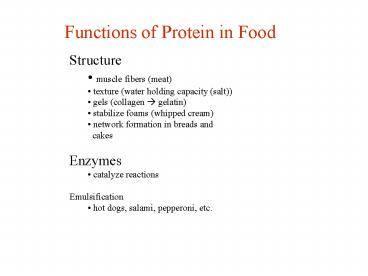Functions of Protein in Food PowerPoint PPT Presentation
1 / 52
Title: Functions of Protein in Food
1
Functions of Protein in Food
- Structure
- muscle fibers (meat)
- texture (water holding capacity (salt))
- gels (collagen ? gelatin)
- stabilize foams (whipped cream)
- network formation in breads and
- cakes
- Enzymes
- catalyze reactions
- Emulsification
- hot dogs, salami, pepperoni, etc.
2
Proteins of Animal Origin
- Meat, fish, and poultry
- soluble- enzymes, actin, myosin
- insoluble- connective tissue
- (muscle- 18-20 protein)
- Milk
- caseins (80 of total)
- lactoglobulin
- immunoglobulin
- Eggs
- yolk- 33 protein, 67 lipid
- white- 12 protein
3
Proteins of Plant Origin
Vegetable- generally not a good source of
protein Cereal- mainly found in the endosperm as
opposed to the germ and bran wheat barley
rye oats corn rice
4
Major Cereal Proteins
- Wheat Endosperm
- Gluten (11 mixture of gliadin and glutenin),
used for flour doughs because of elastic and
cohesive properties (80-85 ) - Albumins and globulins- they coagulate and used
to make foams (15- 20 )
5
Major Cereal Proteins
- Corn Proteins
- 40-50 zein
- 20-30 glutelin
- Rice Proteins
- high in glutelins
- low in lysine
- Seed Proteins (mostly globulins)
- Legums- soybeans, peanuts, peas, beans (20-50
protein) - Oilseeds- sunflower, sesame, cotton seed (20-30
protein)
6
Soybean Contaminants
Trypsin inhibitor- prevents proteolysis Hemagglut
ins- causes red blood cells to agglutinate Saponi
ns- glucosides (surfactants) Estrogens-
hormone Goitrogens- cause goiters
(Proper heat treatment required to destroy)
7
(No Transcript)
8
(No Transcript)
9
(No Transcript)
10
(No Transcript)
11
(No Transcript)
12
(No Transcript)
13
(No Transcript)
14
(No Transcript)
15
(No Transcript)
16
(No Transcript)
17
(No Transcript)
18
(No Transcript)
19
(No Transcript)
20
(No Transcript)
21
(No Transcript)
22
(No Transcript)
23
(No Transcript)
24
(No Transcript)
25
(No Transcript)
26
(No Transcript)
27
(No Transcript)
28
(No Transcript)
29
(No Transcript)
30
(No Transcript)
31
(No Transcript)
32
(No Transcript)
33
(No Transcript)
34
(No Transcript)
35
(No Transcript)
36
(No Transcript)
37
(No Transcript)
38
(No Transcript)
39
Typical Scheme for Protein Isolation
- homogenization
- grinding
- sonication
- osmotic pressure
e.g., protamine sulfate
e.g., ammonium sulfate
- gel filtration
- ion-exchange
- affinity
- PAGE
- native
- SDS
40
Ammonium Sulfate Fractionation
- Increasing the salt concentration will cause
proteins to precipitate out of solution (i.e.,
salting out). - Different proteins are soluble at different salt
concentrations (i.e., basis for fractionation).
41
Gel Filtration Chromatography
42
Elution Profile after Gel Filtration
Chromatography
43
(No Transcript)
44
Molecular Weight Determination by Gel Filtration
Chromatography
45
Ion-Exchange Chromatography
46
Elution of Protein with Salt from an Ion-Exchange
Column
47
Affinity Chromatography Based on an Antigen Ligand
48
Affinity Chromatography Based on an Antibody
Ligand
49
Polyacrylamide Gel with Tunnels for Separation
50
Treatment of Protein with Sodium Dodecyl Sulfate
Proteins is a negatively charged rod
51
SDS-polyacrylamide Gel Electrophoresis
52
SDS-Polyacrylamide Gel Electrophoresis Analysis

